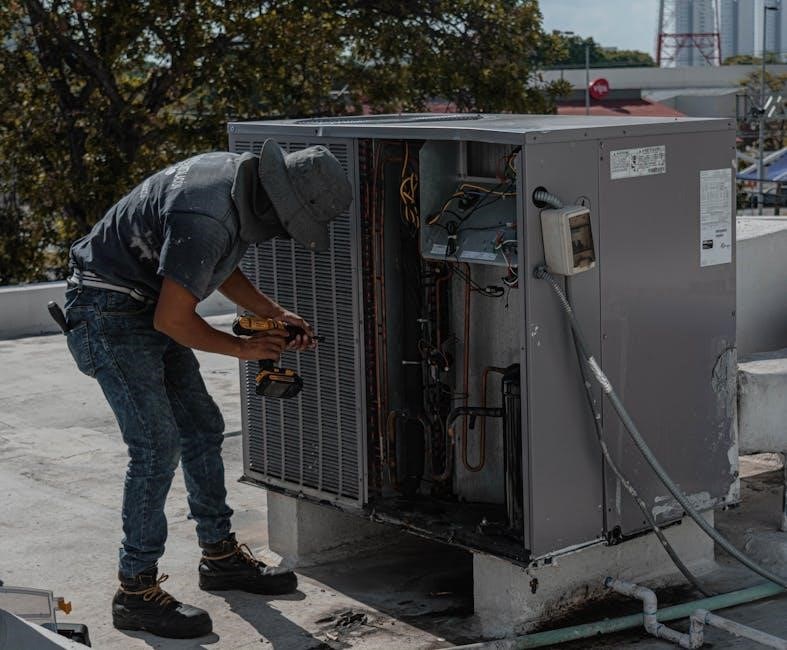Honeywell Air Conditioner Thermostat Manual: A Comprehensive Guide
This guide provides a comprehensive overview of Honeywell air conditioner thermostat manuals․
It covers various types, key features, troubleshooting, wiring, and how to find the correct manual․
Understanding your thermostat helps ensure efficient and comfortable climate control․
Understanding Honeywell Thermostat Manuals

Honeywell thermostat manuals are essential resources for operating and maintaining your HVAC system․
These manuals provide detailed instructions on installation, programming, and troubleshooting, ensuring optimal performance․
Understanding these manuals empowers users to effectively manage their home climate and energy consumption․
Each manual is tailored to a specific thermostat model, outlining its unique features and functionalities․
By consulting the manual, users can learn how to program schedules, adjust temperature settings, and utilize smart features․
Moreover, manuals offer guidance on diagnosing common issues, such as connectivity problems or system malfunctions․
They often include wiring diagrams, troubleshooting steps, and contact information for technical support․
Whether you’re a new homeowner or a seasoned HVAC user, familiarizing yourself with the Honeywell thermostat manual is crucial for maximizing comfort and efficiency․
These manuals serve as a valuable reference for both basic operations and advanced configurations․
By leveraging the information within, you can ensure your Honeywell thermostat operates smoothly and effectively for years to come․
Types of Honeywell Thermostat Manuals
Honeywell provides various types of thermostat manuals to cater to different user needs․
These manuals include user manuals/owner’s guides, installation manuals, and operating manuals․
User manuals or owner’s guides are the most common, offering instructions on programming and using the thermostat for heating and cooling․
Installation manuals provide step-by-step guidance on how to properly install the thermostat, including wiring and mounting instructions․
Operating manuals delve into the specific functions and features of the thermostat, explaining how to navigate the interface and customize settings․
Each type of manual serves a distinct purpose, ensuring users have the information they need for their specific task․
Whether you’re setting up a new thermostat, troubleshooting an issue, or simply learning about its capabilities, there’s a manual tailored to your needs․
By understanding the different types of manuals available, users can quickly locate the information they require․
These resources are essential for maximizing the performance and lifespan of your Honeywell thermostat․
Furthermore, they contribute to a more comfortable and energy-efficient home environment․

User Manuals/Owner’s Guides
User manuals, also known as owner’s guides, are the primary resource for understanding and operating your Honeywell thermostat․
These manuals provide detailed instructions on how to program the thermostat, set schedules, and adjust temperature settings for optimal comfort and energy savings․
They typically cover basic operations, such as setting the time and day, selecting the system mode (heat, cool, auto, or off), and adjusting the fan settings (auto or on)․
User manuals also explain how to use advanced features, such as programmable settings, smart response technology, and Wi-Fi connectivity․
Furthermore, they often include troubleshooting tips for common issues, such as display problems, temperature discrepancies, or connectivity errors․
These guides are designed to be user-friendly, with clear explanations and diagrams to help users navigate the thermostat’s functions․
They also contain important safety information and maintenance recommendations to ensure the longevity and proper functioning of the device․
Whether you’re a new user or an experienced homeowner, the user manual is an invaluable tool for maximizing the benefits of your Honeywell thermostat․
Consulting the user manual can help you optimize energy consumption and maintain a comfortable home environment․
Keep the user manual in a safe place for future reference․
Installation Manuals

Installation manuals are specifically designed for professionals or experienced individuals who are installing a Honeywell thermostat for the first time or replacing an existing one․
These manuals provide step-by-step instructions on how to properly mount the thermostat, connect the wiring, and configure the system settings․
They often include detailed diagrams and schematics to illustrate the wiring connections for different types of heating and cooling systems, such as gas furnaces, electric heat pumps, and central air conditioners․
Installation manuals also cover important safety precautions, such as turning off the power before working with electrical components․
They provide guidance on how to identify the system type and ensure compatibility with the thermostat․
Furthermore, these manuals include information on how to calibrate the thermostat and test its functionality after installation․
Proper installation is crucial for ensuring accurate temperature readings, reliable performance, and energy efficiency․
Incorrect wiring or configuration can lead to system malfunctions, damage to equipment, or safety hazards․
Therefore, it is essential to carefully follow the instructions in the installation manual and consult with a qualified HVAC technician if you have any doubts or concerns․
The installation manual is a critical resource for ensuring a successful and safe thermostat installation․
Always refer to the installation manual before attempting to install a Honeywell thermostat․
Operating Manuals
Operating manuals are essential for understanding the day-to-day functions and features of your Honeywell thermostat․
These manuals provide clear instructions on how to navigate the thermostat’s interface, adjust temperature settings, and utilize its various modes․
They explain how to set the desired temperature, switch between heating and cooling modes, and activate the fan․
Operating manuals often include detailed explanations of the thermostat’s display, including the meaning of different icons and symbols․
They also cover advanced features such as programmable scheduling, which allows you to set different temperatures for different times of the day or week․
Furthermore, operating manuals provide guidance on how to use the thermostat’s override functions, which allow you to temporarily adjust the temperature outside of the programmed schedule․
They may also include information on energy-saving tips and best practices for optimizing your heating and cooling system’s performance․
Operating manuals are designed to be user-friendly and easy to understand, even for those who are not familiar with thermostat technology․
They provide a comprehensive overview of the thermostat’s capabilities, empowering you to take full control of your indoor climate․
By carefully reading and understanding the operating manual, you can ensure that you are using your Honeywell thermostat effectively and efficiently․
This will help you to maintain a comfortable and energy-efficient home environment․
Regularly referring to the operating manual can also help you troubleshoot minor issues and prevent more serious problems from developing․
Key Features Described in Manuals
Honeywell thermostat manuals meticulously detail the device’s key features, ensuring users fully grasp its capabilities․
These manuals comprehensively explain features like Wi-Fi connectivity, enabling remote control via smartphone apps, allowing temperature adjustments from anywhere․
Smart Response Technology, which learns your heating/cooling patterns for optimized comfort and energy efficiency, is also thoroughly described․
Programmable settings and scheduling functionalities are extensively covered, guiding users on setting customized temperature schedules for different days and times․
The manuals elaborate on energy-saving modes, highlighting how to minimize energy consumption without sacrificing comfort․
Display settings, including backlight adjustments and temperature unit preferences (Celsius or Fahrenheit), are also explained in detail․
Furthermore, manuals address features like filter change reminders, alerting users when filter replacement is necessary for optimal system performance․
Some manuals also cover advanced features such as geofencing, which automatically adjusts the temperature based on your location․
Learning about these features through the manual empowers users to efficiently manage their home’s climate․
Understanding these details helps users make informed decisions about their thermostat settings․
The manuals serve as a valuable resource for both new and experienced users, unlocking the full potential of their Honeywell thermostat․
This ensures a comfortable, energy-efficient, and personalized home environment․
Essentially, these manuals are key to unlocking the full potential of your thermostat․
Wi-Fi Connectivity and Remote Control
Honeywell thermostat manuals provide detailed instructions on setting up and utilizing Wi-Fi connectivity for remote control․
The manuals guide users through the process of connecting their thermostat to their home Wi-Fi network, ensuring a stable and secure connection․
They explain how to download and install the Honeywell Home app on smartphones or tablets, providing step-by-step instructions for initial setup․
The manuals detail how to register the thermostat within the app, enabling remote access and control from anywhere with an internet connection․
Users learn how to adjust temperature settings, create and modify schedules, and view current system status through the app interface․
The manuals also cover advanced features like push notifications, alerting users to temperature changes, system errors, or filter replacement reminders․
Troubleshooting tips are provided to address common Wi-Fi connectivity issues, such as lost connections or incorrect network settings․
Security measures are explained, emphasizing the importance of strong passwords and secure network configurations to protect against unauthorized access․
The manuals also highlight the benefits of remote control, such as energy savings through optimized scheduling and the ability to adjust temperatures while away․
They also describe how to integrate the thermostat with other smart home devices and platforms, such as Amazon Alexa or Google Assistant․
This allows for voice-controlled temperature adjustments and seamless integration into a broader smart home ecosystem․
Essentially, these manuals empower users to effortlessly manage their home’s climate from anywhere․
It ensures comfort, energy efficiency, and peace of mind․
Smart Response Technology
Honeywell’s Smart Response Technology is a key feature detailed in their thermostat manuals, offering intelligent climate control․
The manuals explain how this technology allows the thermostat to “learn” a home’s heating and cooling patterns over time․
By analyzing these patterns, the thermostat can predict how long it takes to reach desired temperature settings․
This predictive capability enables the thermostat to activate the heating or cooling system earlier than a standard timer-based schedule․
The result is that the home reaches the setpoint temperature precisely when programmed, enhancing comfort and energy efficiency․
Manuals describe how to enable and customize the Smart Response Technology settings to suit individual preferences․
They provide guidance on adjusting the learning period and sensitivity of the system to optimize its performance․
Troubleshooting tips are included to address potential issues, such as inaccurate temperature predictions or inconsistent performance․
The manuals emphasize the benefits of Smart Response Technology, including reduced energy consumption and improved comfort levels․
They highlight how the thermostat adapts to changing weather conditions and seasonal variations․
This ensures consistent and efficient climate control throughout the year․
Additionally, the manuals explain how the technology can help users save money on their energy bills by minimizing wasted energy․
They also demonstrate how to override the Smart Response Technology settings when needed, such as during periods of extended absence․
The manuals provide a comprehensive understanding of how to leverage this advanced feature for optimal home comfort and energy savings․
Programmable Settings and Scheduling
Honeywell thermostat manuals provide detailed instructions on utilizing programmable settings and scheduling features․
These sections guide users through creating customized heating and cooling schedules tailored to their daily routines․
The manuals explain how to set different temperatures for various times of the day and days of the week․
This allows users to optimize energy consumption by reducing heating or cooling during periods of absence or sleep․
Step-by-step instructions are provided for navigating the thermostat’s interface and programming specific schedules․
The manuals describe how to create multiple schedules to accommodate different lifestyles or seasonal changes․
They also outline how to set temporary overrides, allowing users to adjust the temperature without affecting the programmed schedule․
Detailed explanations are given for understanding the various programming options, such as 7-day, 5-2 day, and 1-week scheduling․
Troubleshooting tips are included to address common issues, such as incorrect programming or schedule conflicts․
The manuals emphasize the importance of accurate time and date settings for proper schedule execution․
Visual aids, such as diagrams and screenshots, are often included to assist users in navigating the programming process․
The benefits of using programmable settings are highlighted, including energy savings and increased comfort․
Users are encouraged to experiment with different schedules to find the optimal balance between comfort and energy efficiency․
The manuals also describe how to reset the thermostat to its factory default settings if needed․
They provide comprehensive guidance on how to leverage these features for optimal home comfort and energy savings․
Troubleshooting Information in Manuals
Honeywell thermostat manuals dedicate significant sections to troubleshooting common issues;
These sections act as a first point of reference for users experiencing problems with their thermostat․
The manuals typically include a list of frequently asked questions and their corresponding solutions․
Common issues covered include the thermostat not turning on, inaccurate temperature readings, and scheduling problems․
Step-by-step troubleshooting guides are provided for each issue, helping users diagnose and resolve the problem․
The manuals often include diagrams and illustrations to aid in identifying specific components or wiring configurations․
They may also provide instructions on how to reset the thermostat to its factory default settings․
The troubleshooting sections often address issues related to Wi-Fi connectivity and remote control․
Users are guided through the process of checking their internet connection and ensuring proper thermostat configuration․
The manuals also include information on error codes and their meanings, allowing users to identify the root cause of the problem․
They provide instructions on how to clear error codes and restore the thermostat to normal operation․
The troubleshooting sections may also address issues related to system compatibility and wiring․
Users are advised to consult a qualified technician if they are unable to resolve the problem themselves․
The manuals emphasize the importance of safety precautions when working with electrical components․
They provide warnings against attempting repairs beyond the user’s skill level and recommend seeking professional assistance․
Ultimately, the troubleshooting information aims to empower users to resolve minor issues independently, saving time and money․
Wiring Diagrams and System Compatibility
Honeywell thermostat manuals offer detailed wiring diagrams crucial for proper installation and operation․
These diagrams illustrate how to connect the thermostat to various HVAC systems, ensuring compatibility․
System compatibility information specifies which types of heating and cooling systems the thermostat supports․
Manuals often include diagrams for heat pump systems, conventional furnaces, and other configurations․
The diagrams clearly label each wire and its corresponding terminal on the thermostat and HVAC equipment․
Color-coding is frequently used to simplify the wiring process and reduce the risk of errors․
The manuals provide instructions on identifying the type of system, such as gas, electric, or oil․
This identification helps users select the correct wiring diagram for their specific setup․
Detailed steps are provided for connecting the wires, including stripping, inserting, and securing them․
The manuals emphasize the importance of disconnecting power to the HVAC system before wiring․
Safety precautions are outlined to prevent electrical shock and damage to the equipment․
Information on identifying common wiring issues, such as loose connections or incorrect wiring, is included․
The manuals may also provide guidance on troubleshooting wiring problems and resolving compatibility issues․
Users are advised to consult a qualified HVAC technician if they are unsure about the wiring process․
The manuals aim to empower users to safely and correctly wire their thermostats, ensuring optimal performance․
Understanding wiring diagrams and system compatibility is essential for a successful thermostat installation․

Finding the Right Manual for Your Model
Wiring Heat Pump Systems
Honeywell thermostat manuals provide specific wiring instructions for heat pump systems․
Heat pump systems differ from conventional systems, requiring unique wiring configurations․
The manuals detail how to connect the thermostat to the reversing valve, compressor, and fan․
Wiring diagrams illustrate the proper placement of wires on the thermostat terminals for heat pumps․
Color-coded wiring diagrams are used to simplify the process and reduce the risk of errors․
The manuals explain the function of each wire, such as the Y wire for cooling and O/B wire for reversing valve․
Specific instructions are given for connecting the auxiliary heat or emergency heat wires․
The manuals highlight the importance of correctly identifying the heat pump type, whether it is a single-stage or multi-stage system․
Different wiring configurations may be required depending on the heat pump type․
The manuals provide guidance on setting the thermostat configuration to match the heat pump system․
Troubleshooting tips are included for common wiring problems with heat pump systems․
The manuals may include information on using a multimeter to test the wiring connections․
Safety precautions are emphasized to prevent electrical shock and damage to the equipment․
Users are advised to consult a qualified HVAC technician if they are unsure about the wiring process․
The manuals aim to empower users to safely and correctly wire their thermostats to heat pump systems․
Proper wiring is crucial for optimal performance and energy efficiency of heat pump systems․
Understanding the specific wiring requirements for heat pump systems is essential for a successful installation․

